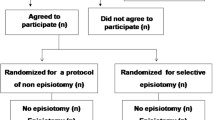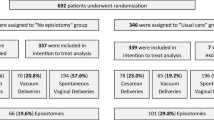Abstract
Objective
To compare the outcome of restricted versus routine use of episiotomy in a tertiary care center.
Method
A prospective observational study was conducted for singleton normal vaginal term deliveries. Deliveries managed with routine use of episiotomy formed the ‘Control Group’, while those managed with restricted use of episiotomy formed the ‘Study Group’. Data so obtained was analyzed.
Results
Total number of deliveries analyzed was 458 (‘Control Group’: n=210, ‘Study Group’: n=248). Restricted use of episiotomy led to 64% (n=159) women delivering without any perineal laceration, in ‘Study Group’. This translated into 41% (n=38) reduction in the number of perineal lacerations in primipara, and 23% (n=36) in multipara, compared to the ‘Control Group’. Only 2% of primipara in ‘Study Group’ had severe third degree perineal tears.
Conclusion
Restricted use of episiotomy resulted in considerable reduction in maternal morbidity due to perineal lacerations.
Similar content being viewed by others
Reference
Low LK, Seng JS, Murtland TL, et al, Clinician — specific episiotomy rates: impact on perineal outcomes. J Midwifery Womens Health. 2000;45:87–93
Hartmann K, Viswanathan M, Palmieri R, et al. Outcomes of routine episiotomy: a systematic review. JAMA 2005;293:2141–2148.
American College of Obstetricians and Gynecologists. Episiotomy. ACOG Practice Bulletin No. 71. Obstet Gynecol 2006;107:957–962.
Sartore A, De Seta F, Maso G, et al. The effects of mediolateral episiotomy on pelvic floor function after vaginal delivery. Obstet Gynecol 2004;103:669–673.
Bhatia JC and Cleland J. Determinants of maternal care in a region of South India, Health Transition Review 5, 1995, 127–142.
Macarthur AJ, Macarthur C. Incidence, severity, and determinants of perineal pain after vaginal delivery: a prospective cohort study. Am J Obstet Gynecol 2004;191: 1199–1204.
Signorello LB, Harlow BL, Chekos AK, et al. Postpartum sexual functioning and its relationship to perineal trauma: a retrospective cohort study of primiparous women. Am J Obstet Gynecol 2001;184:881–890.
Anthony S, Buitendijk SE, Zondervan KT, van Rijssel EJ, Verkerk PH. Episiotomies and the occurrence of severe perineal lacerations. Br J Obstet Gynaecol 1994;101: 1064–1067.
Author information
Authors and Affiliations
Corresponding author
Rights and permissions
About this article
Cite this article
Saxena, R.K., Sandhu, G.S., Babu, K.M. et al. Restricted use of episiotomy. J Obstet Gynecol India 60, 408–412 (2010). https://doi.org/10.1007/s13224-010-0067-3
Received:
Accepted:
Published:
Issue Date:
DOI: https://doi.org/10.1007/s13224-010-0067-3




